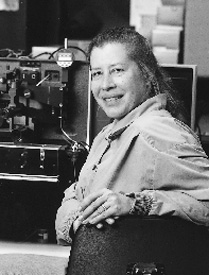Our Science – Sharrow Website
Susan O. Sharrow, B.Sc.
 |
|
|||||||||||||||||||
Biography
Mrs. Sharrow joined the Experimental Immunology Branch as a chemist after receiving a B.Sc. in biochemistry from Michigan State University. In 1973, she established the first immunology-oriented flow cytometry laboratory on the East Coast. A member of the American Association of Immunologists, Mrs. Sharrow's primary research interests have been in the areas of thymocyte development and major histocompatibility antigen expression.
Research
Flow Cytometry in Immunobiology
Flow cytometry (FCM) is a unique experimental technology that provides rapid, quantitative, multiparametric, single cell analysis and separation. The mission of the Flow Cytometry Laboratory of the Experimental Immunology Branch (EIB) encompasses two related programs. First, basic research support is provided to members of the EIB and, on a limited basis, to investigators elsewhere at the NIH. The laboratory staff also participates in developments of flow cytometry applications and resources for use in immunological research. Resource development in the lab includes advances in instrumentation, reagents, methodology, and computer hardware/software. Since 1973, the laboratory has trained over 250 investigators in the principles and practice of flow cytometry. More than 50 of these investigators have established flow cytometry laboratories worldwide. Instrumentation includes two customized three-laser (two tunable argon or krypton and rhodamine 6G argon-pumped dye laser) flow cytometers with electronic cell separation capabilities that are operated by staff of the Flow Cytometry Laboratory in support of multiple research projects. These investigations involve quantitative, single cell analyses of parameters associated with cells freshly prepared from different species/tissues as well as a wide spectrum of in vitro cultured cells. Cell-associated molecules are measured with a variety of probes, most often fluorochrome-labeled monoclonal antibodies. The laboratory specializes in multicolor immunofluorescence analysis (up to six colors), rare event analysis, and cell separation.
Currently supported projects include the following areas of study: (1) in vivo and in vitro analyses of intracellular signaling via cell surface and intracellular molecules; (2) analyses of cellular defects in animals with genetic or induced immune dysfunction; (3) investigations of T and B cell ontogeny and differentiation; (4) studies of the mechanisms of T cell repertoire generation; (5) analyses of expression of cell surface molecules such as adhesion molecules, receptors, and transplantation antigens; and 6) separation and analyses of genetically engineered cells for studies of intracellular processes.
The laboratory also maintains three single-laser, user-operated flow cytometers for use by members of the EIB. In addition, staff provide training and consultation in flow cytometry techniques, protocol design, reagent selection, and data analysis and presentation. Customized flow cytometry data analysis and data archiving software is developed and maintained, including automated cluster analysis software for statistical classification of quantitative multiparametric data and n-plot graphics display of multiparameter data on either subpopulations or individual cells. Network access is provided such that investigators may access and analyze data remotely from their individual laboratories. Current instrumentation development includes additional high-speed cell sorting capabilities and crossbeam electronic fluorescence compensations.
Collaborators include members of this branch and other principal investigators throughout the Center for Cancer Research.
This page was last updated on 9/5/2008.

